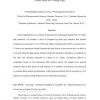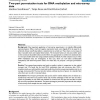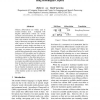10 search results - page 1 / 2 » Testing quasi-independence for truncation data |
MA
2010
Springer
13 years 3 months ago
2010
Springer
Quasi-independence is a common assumption for analyzing truncated data. To verify this condition, we consider a class of weighted log-rank type statistics that include existing te...
VLSI
2005
Springer
13 years 10 months ago
2005
Springer
1 The increasing test data volume required to ensure high test quality when testing a System-on-Chip is becoming a problem since it (the test data volume) must fit the ATE (Automa...
BMCBI
2005
13 years 4 months ago
2005
Background: One important application of microarray experiments is to identify differentially expressed genes. Often, small and negative expression levels were clipped-off to be e...
BMCBI
2008
13 years 4 months ago
2008
Background: False discovery rate (FDR) methods play an important role in analyzing highdimensional data. There are two types of FDR, tail area-based FDR and local FDR, as well as ...
ACL
2008
13 years 6 months ago
2008
Chinese abbreviations are widely used in modern Chinese texts. Compared with English abbreviations (which are mostly acronyms and truncations), the formation of Chinese abbreviati...



